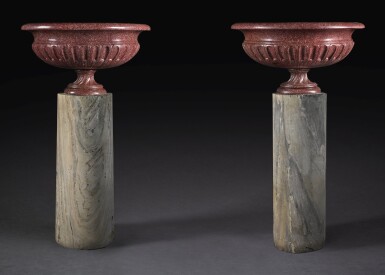
Property from a European Private Collection
A PAIR OF LARGE SCALE ITALIAN CARVED RED EGYPTIAN PORPHYRY OVAL VASES ROME, 18TH CENTURY
Auction Closed
December 4, 11:48 AM GMT
Estimate
100,000 - 150,000 GBP
Lot Details
Description
Property from a European Private Collection
A PAIR OF LARGE SCALE ITALIAN CARVED RED EGYPTIAN PORPHYRY OVAL VASES ROME, 18TH CENTURY
the oval shaped vases with half fluting and gadrooning to lower part of body, on spiralled socles, one socle replaced and of faux porphyry composite
49cm. high, 91cm. wide, 78cm. deep; 1ft. 7¼in., 2ft. 11¾in., 2ft. 6¾in.
Bernard Steinitz, Paris
Biennale des Antiquaires, Paris, 2007.
Dario Del Bufalo, Porphyry, Red Imperial, Power and Religion, 2012, p. 155, V120.
These spectacular vases are rare survivals not only for their impressive scale but also for being a pair. Egyptian porphyry, as a material, stopped being quarried in Ancient times, and its use from the Renaissance onwards was possible by reclaiming the material from Ancient monuments ruins, particularly columns. The sheer size of these pieces reveals the scale of the columns from which they were carved and the herculean effort that would have been involved in transporting those from Egypt in Roman times. They are made of the best quality of this material - latinatto - with the white speckles evenly spread out on the purple ground.
Inspired by the classical navette shape, these oval vases are finely polished with the imposing body well balanced on the elegant and unusually spiraled socle. Dario del Bufalo, in his seminal monograph Porphyry, has dated the present lot as 18th century, which is in line with their more classical appearance and less baroque spirit. A drawing from the Duc d'Aumont Collection sale catalogue shows a yellow marble vase in the sale - acquired by Julliot for Louis XVI - with a comparable design with stop-fluting to its lower section and slightly flared lip (Duc d'Aumont sale, 12 Decembre 1782, p.18, pl.20; fig.1). Another vase, in the Palazzo del Quirinale, recalls their oval shape and has the socle with straight fluting, a very rare element in vases of this material (see Bufalo, p.154, V115) (fig.2).
Nevertheless, 17th century Italian examples give us the best comparisons for some of the individual ornamental elements. The spiralled fluting, as seen in ours, can be seen in the magnificent pair of vases at Chiswick House, acquired by Lord Burlington in Rome in 1715. A vase ordered from Rome by Louis XIV and delivered to him in 1685 (Musée du Louvre, Inv. no. MR2842 OA9230) displays the same use of stop-fluting to the lower body of the vase and of spiralled fluting to the upper section.
